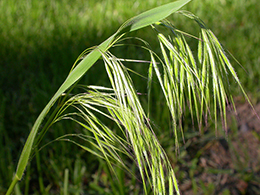On July 7, 2007 a wildfire was started near the town of Milford, Utah after lighting struck a fence post. The flames spread quickly. Officials estimated at times the fire traveled 40 mph as it consumed everything in its path. After it was finally extinguished, the Milford Flat fire had burnt 363,000 acres and ended up costing $17 million to restore. It was the biggest wildfire in the history of Utah. But wildfires happen all the time around the country, and are a natural part of grassland ecosystems. What made this fire different from a typical wildfire? The answer can be found in the fuel that gave the Milford Flat wildfire its voracity. Cheatgrass (Bromus tectorum) a non-native invasive grass took an otherwise typical wildfire and turned it into a monster.
Invasive and Noxious Weed
Cheatgrass, also known as downy brome or Junegrass, is a cool-season annual grass native to Eurasia. In the 1800’s it was introduced to North America from ocean-going ships, and has since spread throughout the United States. It’s particularly troublesome in the West, invading rangelands and outcompeting native grasses. Cheatgrass seems to have the upper-hand in just about every setting. It thrives in disturbed areas such as wildfire scars, construction sites, pastures and along roadsides. It seeds profusely (up to 70 million seeds per acre) and germinates quickly during the fall, winter and spring. It also has no natural biological predators in North America, aiding the advancement of cheatgrass infestations. On top of all these advantages, cheatgrass loves poor soil conditions. From mountain peaks to valley floors, there’s nowhere cheatgrass hasn’t been found. This is one plant truly deserving of its name.
Negative Impacts of Cheatgrass

Controlling the Spread of Cheatgrass
Eradication and control is difficult, but not impossible. Landowners with cheatgrass infestations should contact their local Cooperative Extension office for advice on the best way to deal with outbreaks in their specific area. Mechanical control is one of the most prescribed methods and is effective so long as it’s implemented at an early enough stage. This can involve hand pulling, mowing, trimming and disking the cheatgrass before it has had time to produce seed and die. One of the best ways to control cheatgrass is biologically by allowing livestock to graze the cheatgrass while it’s still young and green. Prescribed burns are not recommended without oversight from your local fire department as burns can easily escape containment. Once a cheatgrass patch has been removed, it’s important to replace it with something else. Cheatgrass will very easily return to land left barren. Replacement can be accomplished by rototilling the area to a depth of three inches and replanting with desirable species. Our pasture grass seed blends offer the perfect replacement for cheatgrass; reclaiming the land and helping to slow the spread of cheatgrass.
Only with vigilance and persistence will we be able to slow the spread of this noxious weed. Landowners, farmers and ranchers can all do their part to make sure their property isn’t harboring cheatgrass. Through proper land maintenance practices and quick responses to outbreaks, this cheater of a grass doesn’t have to be the cause of land degradation or the next monster wildfire.





